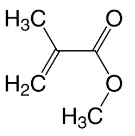
In October 2020, ECHA's Committee for Risk Assessment (RAC) had agreed that MMA, methyl methacrylate should be classified as a category 1 respiratory sensitizer. MMA is a substance used in paints, adhesives and coatings. It is already classified under CLP (Classification Labelling Packaging) as a skin irritant and skin sensitizer.
While the Anses (Agence française de sécurité sanitaire de l’alimentation, de l’environnement et du travail / French Agency for Food, Environmental and Occupational Health Safety) supports the fact that consumers can be exposed to MMA via different way (detergents, paints, and adhesives, etc.), and that a wide range of testing is missing. Industry, on the other hand, disagrees with the addition of MMA as a respiratory sensitizer.
On July 5-6, 2022, Cefic's Methacrylates Sector Group (MSG) shared a document at a meeting of the REACH and CLP Competent Authorities. In this document, Cefic states that the classification decision is "scientifically and legally unfounded". Cefic says it found that the evidence provided by Rac used "unreliable" human data. Thus, according to Cefic, the workers who reported having developed respiratory sensitization were not necessarily in contact with MMA.
What is the impact of a "respiratory/skin sensitization" hazard classification?
All manufacturers, importers and downstream users must classify and label their hazardous substances or mixtures to ensure protection of human health and the environment.
There are different hazard classes:
- Carcinogenicity
- Mutagenicity
- Toxicity for reproduction
- Respiratory sensitizers
Within the European Union (EU), it is mandatory to establish a harmonized classification and labeling for all substances of concern (which fall into one of the above mentioned hazard classes).
This harmonized classification (CLH) is listed in Annex VI of the CLP Regulation. ECHA provides a database of the C&L inventory including the list of harmonized classifications.
The hazard class "respiratory/skin sensitization" is divided into 2 categories:
- Category 1 respiratory sensitizers and subcategories 1A and 1B
- Category 1 and sub-category 1A and 1B skin sensitizers
If a product is already classified as a sensitizer, and contains a substance that is part of this hazard class, then the product must be labeled with the sensitizing substance.
If a product is not already classified as a sensitizer, it must be stated on the label "contains (name of substance)" / "may produce an allergic reaction".
Finally, it is mandatory to establish a SDS (Safety Data Sheet) for the product.
Properties of Methyl Methacrylate
IUPAC Name : methyl 2-methylprop-2-enoate
Molecular Formula : C5H8O2
Structure :

SMILES : CC(=C)C(=O)OC
CAS Number : 80-62-6
CE Number : 201-297-1
Density : 0,93g/mL
Molecular Weight : 100,12g/mol
Appearance : crystalline powder or crystals
Hazard statements :
- H225 - Highly flammable liquid and vapour
- H335 - May cause respiratory irritation
- H315 - Causes skin irritation
- H317 - May cause an allergic skin reaction
In October 2020, ECHA's Committee for Risk Assessment (RAC) had agreed that MMA, methyl methacrylate should be classified as a category 1 respiratory sensitizer. MMA is a substance used in paints, adhesives and coatings. It is already classified under CLP (Classification Labelling Packaging) as a skin irritant and skin sensitizer.
While the Anses (Agence française de sécurité sanitaire de l’alimentation, de l’environnement et du travail / French Agency for Food, Environmental and Occupational Health Safety) supports the fact that consumers can be exposed to MMA via different way (detergents, paints, and adhesives, etc.), and that a wide range of testing is missing. Industry, on the other hand, disagrees with the addition of MMA as a respiratory sensitizer.
On July 5-6, 2022, Cefic's Methacrylates Sector Group (MSG) shared a document at a meeting of the REACH and CLP Competent Authorities. In this document, Cefic states that the classification decision is "scientifically and legally unfounded". Cefic says it found that the evidence provided by Rac used "unreliable" human data. Thus, according to Cefic, the workers who reported having developed respiratory sensitization were not necessarily in contact with MMA.
What is the impact of a "respiratory/skin sensitization" hazard classification?
All manufacturers, importers and downstream users must classify and label their hazardous substances or mixtures to ensure protection of human health and the environment.
There are different hazard classes:
- Carcinogenicity
- Mutagenicity
- Toxicity for reproduction
- Respiratory sensitizers
Within the European Union (EU), it is mandatory to establish a harmonized classification and labeling for all substances of concern (which fall into one of the above mentioned hazard classes).
This harmonized classification (CLH) is listed in Annex VI of the CLP Regulation. ECHA provides a database of the C&L inventory including the list of harmonized classifications.
The hazard class "respiratory/skin sensitization" is divided into 2 categories:
- Category 1 respiratory sensitizers and subcategories 1A and 1B
- Category 1 and sub-category 1A and 1B skin sensitizers
If a product is already classified as a sensitizer, and contains a substance that is part of this hazard class, then the product must be labeled with the sensitizing substance.
If a product is not already classified as a sensitizer, it must be stated on the label "contains (name of substance)" / "may produce an allergic reaction".
Finally, it is mandatory to establish a SDS (Safety Data Sheet) for the product.
Properties of Methyl Methacrylate
IUPAC Name : methyl 2-methylprop-2-enoate
Molecular Formula : C5H8O2
Structure :

SMILES : CC(=C)C(=O)OC
CAS Number : 80-62-6
CE Number : 201-297-1
Density : 0,93g/mL
Molecular Weight : 100,12g/mol
Appearance : crystalline powder or crystals
Hazard statements :
- H225 - Highly flammable liquid and vapour
- H335 - May cause respiratory irritation
- H315 - Causes skin irritation
- H317 - May cause an allergic skin reaction







